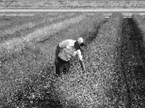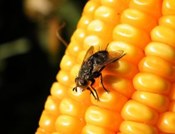Sometimes there is science to be learned in the most unexpected places. Youth can take scientific experiments and utilize them to solve problems in their every day lives. One excellent example of this is the science behind fly management in and around dairy and livestock barns.
There are many pests that can be found in and around dairy and livestock barns, however one of the most common is the house fly. In addition to being a nuisance to the animals, house flies can affect the relationship between a farm and it’s non-farm neighbors due to both their nuisance factor as well as the fact that they have considerable potential for transmitting diseases and parasites. For this reason, this article will focus on the management of the house fly and how youth can study flies and make decisions that will help reduce fly populations.
House flies (Musca domestica) are nonbiting insects that breed in animal droppings, manure piles, decaying silage, spilled feed, bedding, and other organic matter. They can complete their life cycle from egg to adult (egg, larva, and pupa) in 10 days under ideal conditions in summer months. Each female lives 10-21 days and can produce 150 to 200 eggs, which she lays in batches at 3-4 day intervals. One activity that youth can do to get a real feel for how flies breed and multiply is by actually “growning” flies in a controlled environment. Another one would be to go looking for fly eggs, larvae, and pupa on their farm. Common fly breeding sites on livestock operations include locations in and around calf hutches especially inside corners; silo leak and spill areas; animal stalls and pens, feed preparation, storage, and manger areas; near water sources; calf, hospital, and maternity areas; water tanks; feed troughs; inside and outside manure handling areas.
Another experiment would be to monitor house flies using either baited traps or spot cards. Baited traps are gallon plastic milk jugs in which four 2-inch holes have been cut in the upper part of the sides to allow flies attracted to bait placed on the inside bottom of the jug to enter. The traps are suspended from rafters or other building supports with 18-24 inch long wires. Spot cards are 3/5 inch white file cards that are attached to obvious fly resting surfaces (areas with large numbers of fly fecal and regurgitation spots). The number of baited traps or spot cards required will vary according to the size of the barn, but there should be a minimum of five at equidistant locations throughout each animal housing unit. These monitoring devices are left for 7 days. Then the number of flies collected in the traps or the number of fecal and vomit spots on the spot cards are counted. Baited trap catches in excess of 250 flies per week or spot card counts of over 100 spots per card per week are considered high levels of fly activity. House flies in the Northeast are active from May through October; populations peak from mid-July through mid-September.
There are several methods to control flies. Certain practices should be followed no matter what the fly density is and some may be based on the fly density. The first and most important practice involves cultural control practices. Sanitation is the most important practice in effective fly control. The fly life cycle requires that immature flies live in manure, moist hay, spilled silage, wet grain, or a similar environment for 10-21 days depending on temperature. Weekly removal and spreading of materials in which flies breed helps to break the fly’s life cycle. Waste management is therefore the first line of defense in developing an effective fly management program. It is much easier and less costly to prevent a heavy fly buildup than to attempt to control large fly populations once they have become established.
The prime sources of flies in confinement areas are animal pens, especially those housing calves. The pack of manure and bedding under livestock should be cleaned out at least once a week. In free-stall barns the next most important fly breeding area is the stalls, which should be properly drained and designed to encourage complete manure removal. In stanchion barns, drops should be cleaned out daily. Wet feed remaining in the ends of the mangers, as well as green chop and other forage and feed accumulations around silos, are excellent locations for flies to breed and should be cleaned out at least weekly.
Another way to minimize the amount of favorable outdoor fly breeding sites includes spreading manure and bedding as thinly as possible to ensure it dries out quickly. It should also be disked under to help kill fly larvae and pupae that may be present, especially under cool or over cast weather conditions, which slow the manure drying process. Drainage problems that allow manure to mix with mud and accumulate along fence lines in exercise yards should be eliminated. Finally, gaps under feed bunks where moist feed can accumulate should be sealed.
The use of sticky tapes, paper and ribbons are very effective for managing small to moderate fly populations. In the case of more substantial populations, one can use either Biological or Chemical Controls.
In the past, management of flies in dairy and livestock barns often relied solely on insecticide use. But this single-tactic approach can aggravate fly populations’ resistance to insecticides and inadvertently destroy natural enemies of flies. Today successful farmers are combining careful use of pesticides with other integrated pest management (IPM) practices.
An excellent scientific experiment kids can do on the farm is to take flies and put them in two or more jars. One jar they use as a control. Then in each of the other jars they spray different pesticides that are commonly used on flies. This will give them an idea of what the effectiveness is of each and whether there is any resistance�..did the chemical effectively kill the flies?
Flies have natural enemies that are commonly present in dairy and livestock barns. Beetles and mites devour fly eggs and larvae. Ply pupae are attacked by small parasitoids. Unnoticed and unaided by us, these natural bio-control agents can take a heavy toll on the fly population. The species that is best adapted to farms in the northeast is Muscidifurax raptor (looks kind of like a miniature wasp), which attacks fly pupae inside barns as well as outside and is the main naturally occurring parasitoid on our farms. Some farms are purchasing these and releasing them on their farms. A great experiment would be to purchase some of the parasitoids and “feed them” fly pupa and watch them work!!! Note: releasing parasitoids is only effective if certain conditions are met. 1) Waste management is a must, they can’t replace manure management. 2) Make sure any insecticides you use are compatible with parasitoids- you don’t want to buy them then kill them! 3) Make sure you are purchasing the right ones for your farm, not all are the right species for the northeast�.. 4) Start to release them early (May is good) and continue weekly until the middle of August (follow directions for proper release). 5) Release enough! Weekly releases of either 200 per milking cow or 1,000 per calf have proven effective in research trials. But every farm is different, and release rates and schedules may require adjustments to achieve a level that is both effective and affordable for an individual farm. Note: in research trials, the cost of releasing parasitoids has been more than offset by reductions in insecticide treatments.
On average, dairy farmers who use biocontrol in fly IPM programs make 80% fewer insecticide treatments than farmers who rely solely on insecticides for fly control. In addition, fly populations on IPM farms are about 50% lower than on conventionally managed farms. It is important to understand, however, that no single fly management strategy alone will provide long-term control.
By studying flies, their breeding habits and environmental needs, youth can learn practices that will help them control one of the most abundant pest on a farm. Hands on experiments make the information gained “real” and memorable.
The above article was excerpted from Dairy Management Fact Sheet “Integrated Management of Flies In and around Dairy and Livestock Barns” by D. Wes Watson, J. Keith Waldron, and Donald A. Rutz. Department of Entomology, New York Sate IPM Program , Cornell University.




